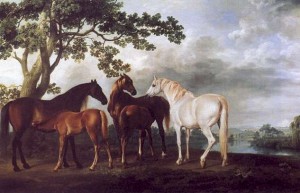Do animals have emotions? The histories of science, literature, philosophy and religion have offered up a range of answers. This series of occasional essays on emotional animals in history offers some materials with which to think about the question.
No. 1. A Weeping Horse in Augsburg, 1705
A popular travel book of the mid-eighteenth century by a certain Monsieur de Blainville, includes the tale of a wonderful little horse, encountered in the German city of Augsburg in 1705. This creature outdid even Alexander the Great’s famous horse, Bucephalus, for its ingenuity and ability. It was, Blainville trumpeted, “the greatest rarity of its kind in the world”.
This creature could do standard horse-like things such as jumping through very narrow hoops, but additionally could dance all sorts of dances, whether lively or more grave, including the Minuet and the Saraband; could march on two, three or four legs; could simulate lameness and death; and could discriminate between red and white wine, as well as playing “an infinity of other pranks”. The wonderful horse’s powers of reason and intelligence were proved by his ability to tell the time on a watch, or the number of points on a playing card, by stamping his foot the requisite number of times.
Most remarkably of all, the wonderful horse of Augsburg wept. When his first owner had died, the “poor beast showed such grief that he shed tears, would not eat for three days, and had almost died of hunger”. “What more is necessary”, Blainville asked, “to entitle this animal to be called a prodigy?”
The idea that horses shed tears of grief when their masters died was an ancient one, affirmed by both Pliny and Aristotle, also appearing in medieval bestiaries, and in the thirteenth-century text De Animalibus, by Thomas Aquinas’s teacher Albertus Magnus.
Blainville’s account reveals that the idea persisted well into the modern period, even after René Descartes had asserted, in the seventeenth century, that animals were automata with no mental life at all. Indeed, Blainville ends his account of the wonderful horse with an explicit attack on those philosophers, including Descartes, who dared to claim that animals were mere clockwork machines.
Blainville’s plea for the mental life of the “brutes” was couched in empiricist terms: it was a matter of observation. Philosophers might think they had constructed a clever theoretical system proving human reason and brute instinct were completely distinct, and showing that animals had no consciousness, no reason, and no soul, Blainville wrote, but “I must believe what I see”. And he knew what he had seen in Augsburg: a weeping and reasoning horse that could join with a chorus of other animals in retorting to Descartes: “We think, and therefore we are.”
Blainville’s argument in favour of animal minds moves on, at this point, to consider the amazing cunning displayed by monkeys thieving collaboratively at the Cape of Good Hope.
Thomas Dixon

